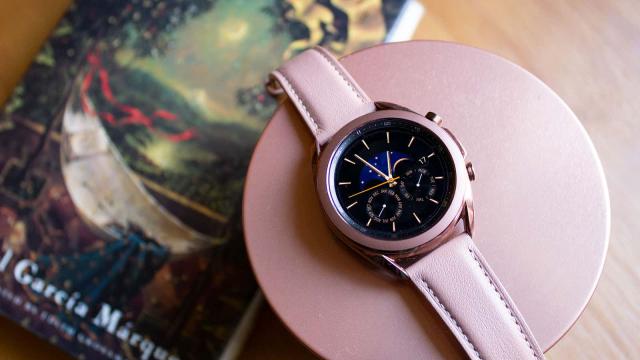Good news for those of you who are eagerly waiting to see what’s new for Android smartwatches. According to a new SamMobile report, Samsung’s next-gen Wear OS devices will be powered by a beefy new chip called the Exynos W920 — and at least on paper, the gains are promising.
Let’s get to the nitty-gritty. The Exynos W920 will reportedly be 1.25 times faster, with 1.5GB of RAM and 8.8 times the graphic performance compared to the Exynos 9110, the chip that’s powered every Samsung smartwatch since the Galaxy Watch. SamMobile also says Samsung specifically created this chip for the new Wear, a unified platform that mashes together the best bits of Tizen OS and the old Wear OS. Just looking at the numbers, this is massive. No Wear OS watch currently on the market has more than 1GB of RAM, and the overwhelming majority are still running on last-gen processors.
These specs dovetail with a rumour we heard in May from leaker Ice Universe, who claimed the new Samsung watches would sport a 5nm processor. But hasn’t Wear OS’s problems been mostly about neglected software and incremental updates? Well, to an extent, yes. However, another massive problem has been that, until now, nearly all Wear OS watches have been powered by Qualcomm’s lacklustre Snapdragon Wear platform. The Snapdragon Wear chips have always used incredibly outdated processor tech, putting it far behind Samsung’s Exynos and Apple’s S-series processors. That in turn led to a chicken-and-egg scenario. No matter what software updates Google would push out, they would always be somewhat hamstrung by the Snapdragon Wear chips.
For years Wear OS languished on the Snapdragon Wear 2100 chip, which was built on 28nm process tech. This was process node tech that was superseded by 22nm in 2012. That’s two years before the first Wear OS — then Android Wear — smartwatches ever showed up. The Snapdragon Wear platform didn’t get a meaningful update until 2018, when Qualcomm announced the Snapdragon Wear 3100 platform.
While it added a co-processor, this chip was also based on 28nm tech. In 2018, both Apple and Samsung had moved on to 7nm and 10nm process tech, respectively. Last June, Qualcomm announced its Snapdragon Wear 4100 platform, which promised to boost processing power from 28nm… to 12nm. While that’s a significant boost, it’s still tech that’s several generations behind. In 2021, there are still only two Wear OS smartwatches that use Qualcomm’s 4100 platform: Mobvoi’s TicWatch Pro 3 and the TicWatch Pro 3 LTE.
This is a big reason why Wear OS smartwatches often felt laggy in comparison to Samsung’s Tizen OS watches, Apple Watches, and less power-intensive Fitbits. It’s also why marquee features like LTE connectivity and sleep-tracking took so long to make their way to Wear OS hardware.
So the fact that the first smartwatches to feature the new unified platform will be powered by chips using current process tech? That’s worth noting. It’s absolutely not a guarantee that the new platform will be outstanding, or that it won’t have growing pains to overcome. However, it’s at least giving this fledging platform a chance to start off on the best foot possible.
When Samsung and Google officially announced their collaboration, Gizmodo asked if it was possible that Samsung might licence its processor tech to other companies in the space. At the time, Samsung declined to comment. It’s very possible that it won’t and that this beefy processor will only work on Samsung watches. However, if it does make its way to other smartwatches, that would be huge. And even if it doesn’t, proving that the new Wear OS could be great on current hardware might give Qualcomm a kick in the butt to stop dragging its feet on updating its Snapdragon Wear platform. Or, who knows? Perhaps it might inspire other vendors to experiment with their own SoC and bypass Qualcomm entirely.
Whatever ends up happening, a capable processor that can showcase Wear OS’s actual potential is long overdue — and it’s reason to hope that Google and Samsung are serious about this new venture succeeding.
